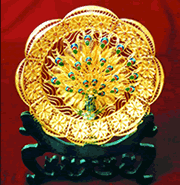The fifth step is polishing, which begins with emery. Polishing aims to even out the filigree and the filled compartments. The whole piece is again put into the fire and then polished once more with a whet-stone. Finally, a piece of hard carbon is used to polish the article a final time to obtain some luster on the surface.
The sixth step is gilding, which is done by placing the article in gold or silver fluid, charged with an electric current. The exposed parts of the filigree and the metal fringes of the article will again undergo another electroplating and a slight polishing.
 Filigree inlays
Filigree inlays
 Filigree inlays, also called "refined metal crafts", are made of gold, silver and other materials inlaid with various kinds of precious stones, pearls, or woven patterns. They fall into two categories: filigree, where gold and silver are made into thin threads and then transformed into craftworks using such techniques as piling and weaving; and inlays, where thin gold and silver strips are hammered into wares, carved with decorative patterns and then inlayed with precious stones.
Filigree inlays, also called "refined metal crafts", are made of gold, silver and other materials inlaid with various kinds of precious stones, pearls, or woven patterns. They fall into two categories: filigree, where gold and silver are made into thin threads and then transformed into craftworks using such techniques as piling and weaving; and inlays, where thin gold and silver strips are hammered into wares, carved with decorative patterns and then inlayed with precious stones.
Filigree inlays took shape as early as in theSpring and Autumn Period(770-476BC), achieved super craftsmanship in the Ming Dynasty and enjoyed great developments in the Qing Dynasty. As a result, many fa mous filigree inlay works have continued to emerge, many becoming articles of tribute for the imperial courts.
mous filigree inlay works have continued to emerge, many becoming articles of tribute for the imperial courts.
The craft of filigree inlays is the most famous in Beijing andChengdu, capital of Southwest China'sSichuan Province. Filigree inlay works in Beijing feature weaving and piling, and dian cui, which refers to pasting blue and green leathers of kingfishers onto gold and silver wares for a better effect. Beijing filigree inlay craftworks were awarded the Excellent Design Award at a Southeast Asian jewelry design contest.

